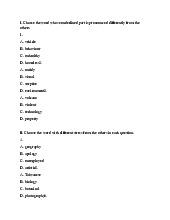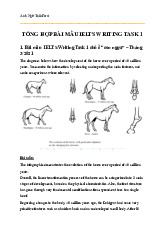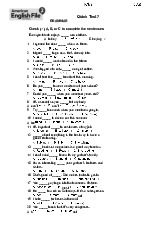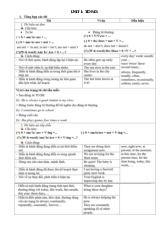




Preview text:
lOMoAR cPSD| 59540283
1. What is the purpose of studying the theoretical approaches to languagelearning?
Answer: Understanding the theoretical approaches (behaviorism, innatism, and
interactionism) helps teachers design methods that align with how students best acquire
language, whether through repetition, innate capabilities, or social interaction.
2. How can Multiple Intelligences theory be applied in English languageteaching?
Answer: Teachers can tailor activities to different intelligences, such as using songs for
musical intelligence, group discussions for interpersonal intelligence, or puzzles for
logical-mathematical intelligence, ensuring diverse engagement and effectiveness.
3. Why is motivation important in language learning?
Answer: Motivation drives learners to put in the effort required to master a language.
It can determine the speed and depth of learning, making it essential for teachers to
inspire and maintain students’ interest.
4. What are some key differences between traditional and modern
Englishteaching methods?
Answer: Traditional methods like Grammar-Translation focus on written text and
translation, while modern methods like Communicative Language Teaching emphasize
interaction, fluency, and real-life usage of the language.
5. What are the advantages of using communicative activities in languageclassrooms?
Answer: Communicative activities encourage active participation, real-world
communication, and peer learning. They help develop fluency and confidence in using English naturally. 6. How can teachers effectively provide feedback on student
performance?Answer: Teachers should offer constructive, specific, and actionable
feedback. This may involve highlighting strengths, addressing errors without
demotivation, and providing strategies for improvement.
7. What role do input and output play in language learning?
Answer: Input (listening and reading) provides learners with exposure to the language,
while output (speaking and writing) allows them to practice and solidify their skills. A
balance between the two ensures comprehensive development.
8. Is it beneficial to use a single teaching method for all English lessons? Why or why not?
Answer: No, because students have diverse learning needs and preferences. A flexible
approach incorporating multiple methods ensures adaptability to various contexts and learner profiles. lOMoAR cPSD| 59540283
9. What are examples of communicative activities, and how should they bedelivered?
Answer: Examples include role-plays, group discussions, and problem-solving tasks.
Teachers should plan clear objectives, provide necessary instructions, monitor
activities, and debrief afterward.
10. What implications does the study of teaching methodologies have for
futureEnglish educators?
Answer: It equips educators with a toolkit of strategies, fosters adaptability, and enables
them to create learner-centered environments that cater to diverse linguistic and cultural backgrounds.
11. What are the main characteristics of the Total Physical Response (TPR) method?
Answer: TPR focuses on physical movement in response to commands. It emphasizes
listening and comprehension, making it particularly effective for beginners or young learners.
12. What is the significance of understanding input and output in languageacquisition?
Answer: Understanding input (e.g., comprehensible language exposure) and output
(e.g., language production) helps teachers create a balanced curriculum that supports
receptive and productive skills development.
13. How can Task-Based Learning (TBLT) improve student engagement?
Answer: TBLT uses real-world tasks, such as planning a trip or conducting interviews,
which are meaningful and practical. This encourages active participation and contextual use of language.
14. Why is it important to consider the advantages and disadvantages of teachingmethods?
Answer: Recognizing the strengths and weaknesses of methods like
Grammar-Translation or Communicative Language Teaching allows educators to make
informed choices that suit their specific teaching goals and student needs.
15. How can teachers influence students' motivation in the classroom?Answer:
Teachers can create a supportive environment, set achievable goals, provide relevant
materials, and recognize student achievements to foster intrinsic and extrinsic motivation.
16. What does Communicative Language Teaching (CLT) emphasize in Englishteaching? lOMoAR cPSD| 59540283
Answer: CLT emphasizes interaction, real-life communication, and fluency. It
prioritizes language use over grammatical accuracy in practical contexts.
17. What are some challenges associated with the Audio-Lingual Method?
Answer: While effective for drilling pronunciation and basic structures, the Audio-
Lingual Method can be monotonous and may not develop learners' ability to use
language creatively in real-life scenarios.
18. What is Project-Based Learning (PBL), and how is it applied in languageclassrooms?
Answer: PBL involves students working on extended projects, such as creating a travel
guide or conducting a survey, to apply language skills collaboratively. It fosters critical
thinking, teamwork, and real-world application.
19. What is the role of feedback in language learning?
Answer: Feedback helps learners recognize errors, build confidence, and improve their
skills. Effective feedback is timely, constructive, and encourages self-reflection.
20. What are the implications of Multiple Intelligences theory for inclusiveeducation?
Answer: By addressing diverse intelligences, such as spatial, linguistic, and
interpersonal, teachers can create inclusive lessons that engage all learners, regardless
of their preferred learning style.
21. What are some strategies for balancing fluency and accuracy in languageteaching?
Answer: Teachers can focus on fluency during communicative activities and accuracy
during structured practice, ensuring students develop both aspects without discouraging risk-taking.
22. How do the Grammar-Translation Method and the Direct Method
differ?Answer: The Grammar-Translation Method focuses on translation and
grammar rules, while the Direct Method emphasizes immersion, conversational
practice, and contextual language use.
23. Why should teachers consider using multiple teaching methods in theirpractice?
Answer: Different methods cater to varied learning objectives, student preferences, and
classroom contexts. A blended approach ensures adaptability and maximizes learning outcomes.
24. What are some examples of input-rich environments for language
learning?Answer: Input-rich environments include multimedia resources like lOMoAR cPSD| 59540283
videos, podcasts, and authentic texts. These provide varied and engaging language exposure.
25. What steps should teachers follow to design effective communicativeactivities?
Answer: Teachers should define clear goals, select relevant topics, prepare materials,
explain instructions, monitor progress, and provide feedback during and after the activity.
26. Should the teacher use a single method to teach English lessons? Why? orWhy not?
Teacher should not rely on a single method to teach English lessons. Here's why: -
Diverse Learners: Students have different learning styles (visual, auditory,
kinesthetic). A variety of methods caters to these differences, making learning more engaging and effective. -
Evolving Needs: As students progress, their needs change. A single method
might not be suitable for all stages of learning. -
Limited skills development: Different English skills (speaking, listening,
reading, writing) require different approaches. A single method might not be equally effective for all skills. -
Maintaining Interest: A single method can become repetitive and boring, leading
to decreased student engagement. Variety keeps students motivated and focused. - Lack
of Real-World Application: Language use in real life requires flexibility. A single
method might not provide the range of practice needed to use English in various
contexts, such as casual conversation, formal writing, or problem-solving.
27. Giving feedback on student performance is very important in teaching. In what
way should the teacher do this?
1. Be Specific and Actionable: -
Focus on the work, not the person: Avoid personal comments and focus on the
specific aspects of the work that need improvement. -
Provide concrete examples: Point out specific strengths and weaknesses in the student's work. -
Offer suggestions for improvement: Tell students what they can do to improve their performance.
2. Be Timely and Frequent: -
Give feedback promptly: The sooner students receive feedback, the more likely
they are to use it to improve their work. -
Provide ongoing feedback: Don't wait until the end of a unit or semester to give
feedback. Offer regular feedback throughout the learning process.
3. Be Positive and Encouraging: -
Start with positive feedback: Begin by acknowledging the student's strengths and efforts. lOMoAR cPSD| 59540283 -
Use positive language: Avoid negative language that could discourage
students. - Offer constructive criticism: Provide feedback in a way that is helpful and supportive.
4. Encourage Self-Assessment and Reflection: -
Ask students to reflect on their work: Encourage students to think critically about their own performance. -
Provide opportunities for self-assessment: Use tools like rubrics and checklists
to help students evaluate their work. -
Facilitate peer feedback: Encourage students to give and receive feedback from their peers.
5. Tailor Feedback to Individual Needs: -
Consider the student's learning style: Tailor your feedback to the student's preferred learning style. -
Adjust the level of detail: Provide more detailed feedback for struggling students
and less detailed feedback for advanced students. -
Offer different feedback formats: Use a variety of feedback formats, such as
written comments, verbal feedback, and online tools.



